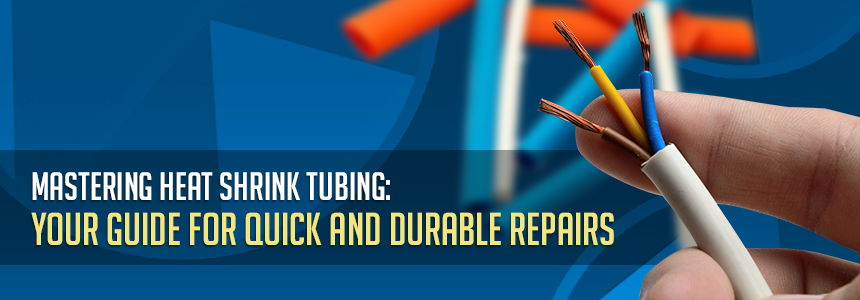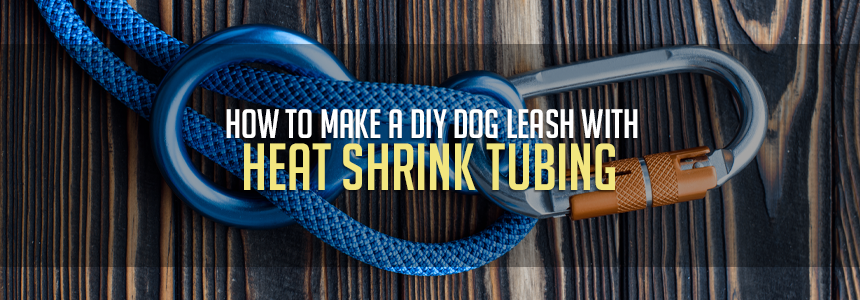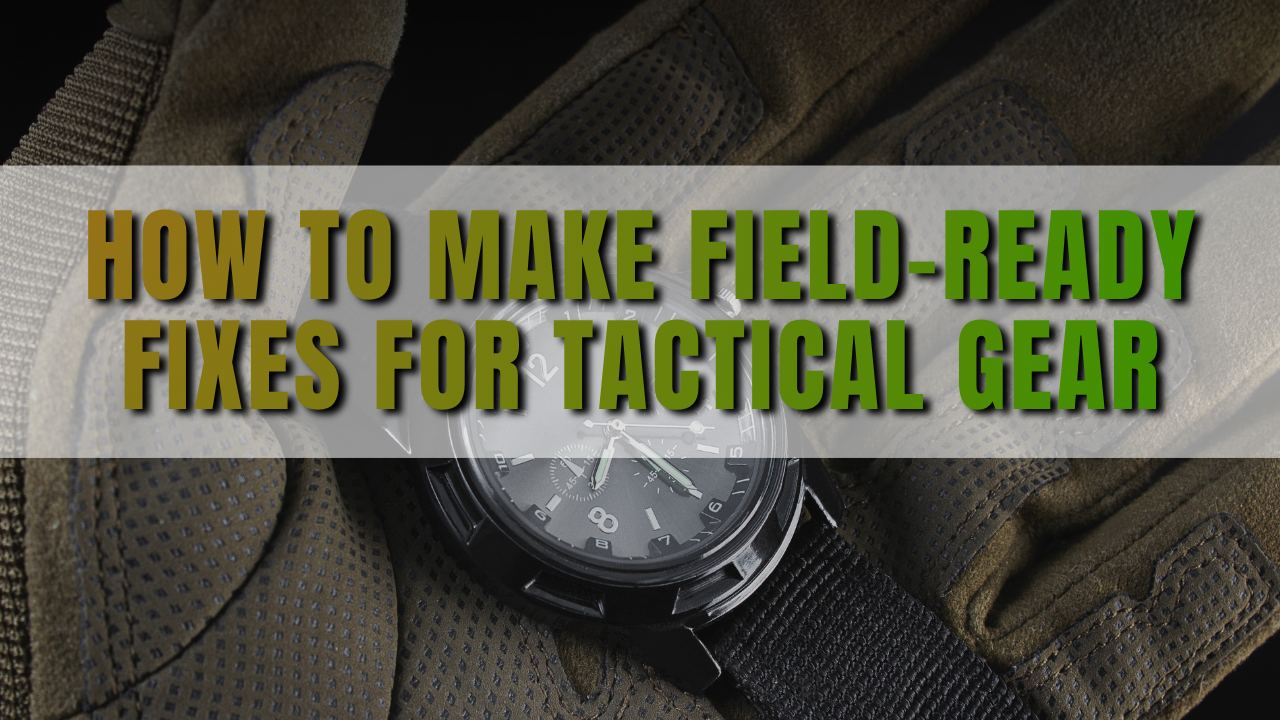Mastering Heat Shrink Tubing: Your Guide for Quick and Durable Repairs

How to Use Heat Shrink Tubing
Your lightning charger, your fishing pole, your backup glasses, your laptop cord, your lucky pen, your last resort...what do you do when it all falls apart?
Replacing well-loved possessions takes time, money, and a trip to the store (at least once). If it's your favorite, last, or only one, replacements just might not be enough. Tape and glue can hold some things together, but with electronic, audio, mechanical, and electrical applications that’s not even an option.
With heat shrink tubing, repairing what you need and love the most is fast and foolproof.
When you're left holding the pieces of what matters most, heat shrink wrap is your difference between none and now.
What Is Heat Shrink Tube?
Heat shrink tubing (also known as shrink wrap tubing) is easy to use and easy to love because it is affordable, adaptable, and industrious. From handy, little plastic tube to impervious, accurate bond between 2 objects, all from a heating and cooling cycle.
The magic ingredient in heat shrink tubing is thermoplastic polymers. These are a special kind of plastic that is scientifically engineered to be:
- Versatile
- Recyclable
- Stretchy
- Strong Soft and pliable when heated
- High tensile strength when cooled
These specialized plastics are also durable, moldable, and handle additives incredibly well. Additions to heat shrink tubing can include adhesive inner liners (also called dual-wall), chemical or corrosive resistances, and fluorination.
Whether you're manufacturing airplanes, modifying car stereos, or making DIY projects there's a heat shrink tube made exactly for your needs.
What Does Heat Shrink Tubing Do?
When heated, the thermoplastic polymers inside a heat shrink tube soften and squeeze around a new surface. Once cool, these closely contoured bonds provide increased resilience, strength, and shielding from elements, abrasions, and accidental exposure to the natural uh-ohs of life.
Heat shrink tubes also offer conductivity, making them the perfect go-to for wires, cords, sound systems, and lighting. There are even specialized butt-splice connectors to simplify and solidify the joining and splicing processes. According to the United States Department of Labor and Occupational Safety and Health Administration, heat-shrinkable insulation covers are the recommended and acceptable way for making splices.
How to Master Heat Shrink in 1-2-3
Using heat shrink tubing at home is so easy, you won’t need any of these:
- no complicated tools
- no training required
- no instruction manual
- no prep-work
- no clean-up
Like a grilled cheese sandwich where the name is the recipe, to use heat shrink tube all you do is “heat and shrink”. Quick fixes and snug repairs have never been more manageable.
Here's a detailed breakdown of our 3-step process.
1. Measure
Projects and heat shrink tubes come in different sizes. When you buy heat shrink tubing, manufacturers and stores sort it by size:
- diameter size
- shrink ratio
Measure twice and cut once.
Choosing tubes by diameter size
These beastly little connectors are circles so we measure them by diameter. How far is it across the middle of the tube from one side to the other?
Measure the tube’s opening exactly with a caliper, measuring tape, string and ruler, or even a phone app. Or you can eyeball it until you find a size tube that fits loosely and provides the surface coverage you want.
The width of tubing you'll need will depend on how thick or thin whatever you're wrapping is. Charging cords are thinner than extension cords. Curtain rods are thicker than fishing poles. Some cords, especially older ones, might have a wider connector at one end, requiring a wider diameter.
What is the heat shrink ratio?
The heat shrink ratio just lets you know what amount of shrinkage to expect. The numbers explain how many times smaller than its original size that tube will become.
- 2:1 heat shrink tube starts 2x bigger than it ends up.
- 3:1 tubing ends up 3x smaller than itself.
- 4:1 tubes are 4x bigger when cold than when shrunk.
- 6:1 heat shrink shrinks down to 6x smaller than its original size.
If your project is relatively uniform in size, choose a smaller ratio. If you need heat shrink tubing to cover something that's both wide and skinny, choose a higher ratio. Focus on finding a size of heat shrink tube that goes on easily, offers full coverage, and has a little wiggle for shrinking.
If guess-and-check is more your style, grab a heat shrink variety kit that offers multiple diameters in precut lengths, guaranteeing you’ll always have the right size on hand no matter what.
2. Cut 'n Slide
Your heat shrink tube needs to be cut about 1/4" longer than the area of damage or repair. Expect 5-15% longitudinal shrinkage.
Some heat shrink tubes come in convenient pre-cut lengths. If not, simple household scissors will do the trick. Cut a slightly longer piece than your coverage requires, slide it over, and then bring on the heat.
3. Shrink
Most thermoplastic polymer tubes react when heated to about 90 degrees Celsius. How you heat them there is up to your safety considerations, available resources, and personal predilections. Some professionals are only heat gun advocates, but lighters, torches, and hair dryers also work.
Check out this BuyHeatShrink.com YouTube video where President Marc Savoy, demonstrates how to use a butane torch instead of a heat gun.
No matter what heat source you choose, don't forget to move.
- If the heat stays in one place too long, you'll end up crisping your tube or your stuff.
- Move the heat source back and forth along the tubing's length while slowly rotating the tube around its circular axis.
- Heating sideways and in circles ensures even heat application across the tube, consistent shrinkage, better bonding, and a stronger final result.
No matter what step or skill level you’re working with, heat shrink is mighty and the application process is forgiving. If you get to “whoops”, all it takes is a few well-directed snips and you’ll be ready to peel it off and try again with a new heat shrink tube.
Our 1-2-3 process makes everyone a heat shrink master.
Oh, The Places Heat Shrink Will Go
Using heat shrink tubing for household repairs is a life changer. Our homes are full of plugs, cords, chargers, adapters, and connections we rely on every day.
As the outer sheath of a cord wears, exposed wires underneath can pose electrical, fire, and safety risks. Charging cables are especially vulnerable to these hazards, particularly at cord-to-connector junctions of older cords.
Wire and cords naturally bend, twist, and kink as they are tucked behind desks, tugged from under car seats, and stretched to reach. Yet time and stress make these well-loved points of use prone to weaknesses in structure and function.
Charging phones can be used from any angle, but charging cords weren't designed to be used at right angles or scrunched into drawers and pockets. Safely nestled inside a tidy, tightly-sealed heat shrink tube, your wires and cords will live longer, happier lives.
Audiophiles, gamers, and techies lean into the solder-free conductivity and precision of heat-shrink tubing connections.
Mechanics and grease monkeys rely on heat shrink because it holds steady through vibrations, temperature fluctuations, liquids, and corrosion. Whether you love wheels, wings, or hulls you can Shop By Industry to find carefully curated, top-of-the-line heat shrink tubing specifically for your get-up-and-go.
When your luxuries and necessities aren't looking or performing their best, heat shrink tubing is the quickest, easiest way to repair, recharge, and relax.
Buy Heat Shrink Tube.
From electrical to acoustical and cords to crafts, heat shrink tube creates fierce, flexible, fast fixes that last.
If it's broken, frayed, splitting, or splayed heat shrink tubing provides the insulation, waterproofing, and protection for you and whatever you’re wrapping up.
Go from none to now with heat shrink tubing. It can hold together everything you treasure.
Explore even more in our Heat Shrink Learning Center or ask us yourself.














